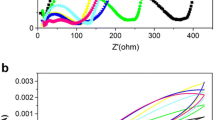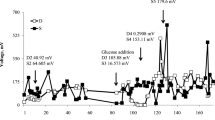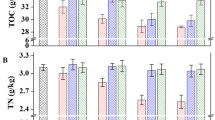Abstract
Purpose
Sediment microbial fuel cells (S-MFCs) are bio-electrochemical devices that are able to oxidize organic matter directly into harvestable electrical power. The flux of organic matter into the sediment is rather low; therefore, other researchers have introduced plants for a continuous supply of organic matter to the anode electrode. Until now only interconnected materials have been considered as anode materials in S-MFCs. Here, granular carbon materials were investigated for their suitability as an anode material in S-MFCs.
Materials and methods
Laboratory microcosms with eight different electrode materials (granules, felts and cloths) were examined with controlled organic matter addition under brackish conditions. Current density, organic matter removal and microbial community composition were monitored using 16S rRNA gene PCR followed by denaturing gradient gel electrophoresis (DGGE). The main parameters investigated were the influence of the amount of electrode material applied to the sediment, the size of the granular material and the electrode configuration.
Results and discussion
Felt material had an overall superior performance in terms of current density per amount of applied electrode material; felt and granular anode obtained similar current densities (approx. 50–60 mA m−2), but felt materials required 29 % less material to be applied. Yet, when growing plants, granular carbon is more suited because it is considered to restore, upon disturbance, the electrical connectivity within the anode compartment. Small granules (0.25–0.5 mm) gave the highest current density compared to larger granules (1–5 mm) of the same material. Granules with a rough surface had a better performance compared to smooth granules of the same size. The different granular materials lead to a selection of distinct microbial communities for each material, as shown by DGGE.
Conclusions
Granular carbon is suitable as an anode material for S-MFCs. This opens the possibility for application of S-MFCs in cultivated areas. In a wider context, the application of granular carbon electrodes can also be an option for in situ bioremediation of contaminated soils.






Similar content being viewed by others
References
Aelterman P, Rabaey K, Clauwaert P, Verstraete W (2006) Microbial fuel cells for wastewater treatment. Water Sci Technol 54:9–15
Aelterman P, Versichele M, Marzorati M, Boon N, Verstraete W (2008) Loading rate and external resistance control the electricity generation of microbial fuel cells with different three-dimensional anodes. Bioresour Technol 99:8895–8902
Boon N, Goris J, De Vos P, Verstraete W, Top EM (2000) Bioaugmentation of activated sludge by an indigenous 3-chloroaniline-degrading Comamonas testosteroni strain, I2gfp. Appl Environ Microbiol 66:2906–2913
Carballa M, Smits M, Etchebehere C, Boon N, Verstraete W (2011) Correlations between molecular and operational parameters in continuous lab-scale anaerobic reactors. Appl Microbiol Biotechnol 89:303–314
Clauwaert P, Rabaey K, Aelterman P, De Schamphelaire L, Ham TH, Boeckx P, Boon N, Verstraete W (2007a) Biological denitrification in microbial fuel cells. Environ Sci Technol 41:3354–3360
Clauwaert P, Van der Ha D, Boon N, Verbeken K, Verhaege M, Rabaey K, Verstraete W (2007b) Open air biocathode enables effective electricity generation with microbial fuel cells. Environ Sci Technol 41:7564–7569
De Schamphelaire L, van den Bossche L, Dang HS, Hofte M, Boon N, Rabaey K, Verstraete W (2008) Microbial fuel cells generating electricity from rhizodeposits of rice plants. Environ Sci Technol 42:3053–3058
Dumas C, Mollica A, Feron D, Basseguy R, Etcheverry L, Bergel A (2008) Checking graphite and stainless anodes with an experimental model of marine microbial fuel cell. Bioresour Technol 99:8887–8894
Helder M, Strik DPBTB, Hamelers HVM, Kuhn AJ, Blok C, Buisman CJN (2010) Concurrent bio-electricity and biomass production in three plant-microbial fuel cells using Spartina anglica, Arundinella anomala and Arundo donax. Bioresour Technol 101:3541–3547
Holmes DE, Bond DR, O’Neil RA, Reimers CE, Tender LR, Lovley DR (2004) Microbial communities associated with electrodes harvesting electricity from a variety of aquatic sediments. Microb Ecol 48:178–190
Jian-hai L, Yu-bin F, Jia L, An-long L, Dong-dong M (2009) Effect of electrode shape on power and internal resistance in benthic microbial fuel cell material on marine sediment. Adv Mat Res 79–82:2195–2198
Kaku N, Yonezawa N, Kodama Y, Watanabe K (2008) Plant/microbe cooperation for electricity generation in a rice paddy field. Appl Microbiol Biotechnol 79:43–49
Logan BE, Hamelers B, Rozendal R, Schröder U, Keller J, Freguia S, Aelterman P, Verstraete W, Rabaey K (2006) Microbial fuel cells: methodology and technology. Environ Sci Technol 40:5181–5192
Mohan SV, Srikanth S, Raghuvulu SV, Mohanakrishna G, Kumar AK, Sarma PN (2009) Evaluation of the potential of various aquatic eco-systems in harnessing bioelectricity through benthic fuel cell: effect of electrode assembly and water characteristics. Bioresour Technol 100:2240–2246
Neumann G, Römheld V (2007) The release of root exudates as affected by the plant physiological status. In: Pinto R, Varanini Z, Nanipieri P (eds) The rhizosphere. Books in soils, plants, and the environment. CRC, Boca Raton, pp 23–72
Pant D, Van Bogaert G, Diels L, Vanbroekhoven K (2010) A review of the substrates used in microbial fuel cells (MFCs) for sustainable energy production. Bioresour Technol 101:1533–1543
Rabaey K, Ossieur W, Verhaege M, Verstraete W (2005) Continuous microbial fuel cells convert carbohydrates to electricity. Water Sci Technol 52:515–523
Read S, Marzorati M, Guimaraes BCM, Boon N (2011) Microbial resource management revisited: successful parameters and new concepts. Appl Microbiol Biotechnol 90:861–871
Reimers CE, Tender LM, Fertig S, Wang W (2001) Harvesting energy from the marine sediment–water interface. Environ Sci Technol 35:192–195
Scott K, Cotlarciuc I, Hall D, Lakeman JB, Browning D (2008) Power from marine sediment fuel cells: the influence of anode material. J Appl Electrochem 38:1313–1319
Strik DPBTB, Hamelers HVM, Snel JFH, Buisman CJN (2008) Green electricity production with living plants and bacteria in a fuel cell. Int J Energ Res 32:870–876
Tender LM, Gray SA, Groveman E, Lowy DA, Kauffman P, Melhado J, Tyce RC, Flynn D, Petrecca R, Dobarro J (2008) The first demonstration of a microbial fuel cell as a viable power supply: powering a meteorological buoy. J Power Sources 179:571–575
Timmers RA, Strik DPBTB, Hamelers HVM, Buisman CJN (2010) Long-term performance of a plant microbial fuel cell with Spartina anglica. Appl Microbiol Biotechnol 86:973–981
Tripisciano C, Kozynchenko OP, Linsberger I, Phillips GJ, Howell CA, Sandeman SR, Tennison SR, Mikhalovsky SV, Weber V, Falkenhagen D (2011) Activation-dependent adsorption of cytokines and toxins related to liver failure to carbon beads. Biomacromolecules 12:3733–3740
Williams KH, Nevin KP, Franks A, Englert A, Long PE, Lovley DR (2010) Electrode-based approach for monitoring in situ microbial activity during subsurface bioremediation. Environ Sci Technol 44:47–54
Yuan Y, Zhou SG, Zhuang L (2010) A new approach to in situ sediment remediation based on air-cathode microbial fuel cells. J Soils Sediments 10:1427–1433
Zhang T, Gannon SM, Nevin KP, Franks AE, Lovley DR (2010) Stimulating the anaerobic degradation of aromatic hydrocarbons in contaminated sediments by providing an electrode as the electron acceptor. Environ Microbiol 12:1011–1020
Acknowledgments
This research received funding from the European Community Seventh Framework Programme FP7/2007-2013 under grant agreement no. 226532. The authors gratefully acknowledge Matthieu Picot, University de Rennes 1, for help with SEM analysis. Tim Lacoere is thanked for help with the molecular biological analysis. The authors thank Jo de Vrieze and Carlos Zamalloa for helpful suggestions and fruitful discussions.
Author information
Authors and Affiliations
Corresponding author
Additional information
Responsible editor: Gijs Breedveld
Rights and permissions
About this article
Cite this article
Arends, J.B.A., Blondeel, E., Tennison, S.R. et al. Suitability of granular carbon as an anode material for sediment microbial fuel cells. J Soils Sediments 12, 1197–1206 (2012). https://doi.org/10.1007/s11368-012-0537-6
Received:
Accepted:
Published:
Issue Date:
DOI: https://doi.org/10.1007/s11368-012-0537-6




